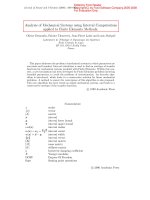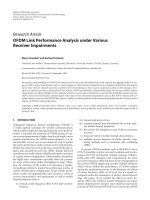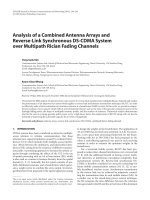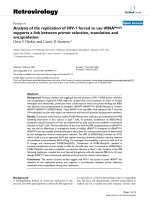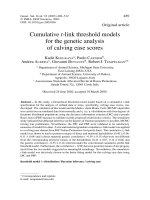03 link analysis pagerank
Bạn đang xem bản rút gọn của tài liệu. Xem và tải ngay bản đầy đủ của tài liệu tại đây (38.1 MB, 54 trang )
CS224W: Analysis of Networks
Jure Leskovec, Stanford University
¡
Today we will talk about how does the
Web graph look like:
§ 1) We will take a real system: the Web
§ 2) We will represent it as a directed graph
§ 3) We will use the language of graph theory
v
§ Strongly Connected Components
§ 4) We will design a computational
experiment:
Out(v)
§ Find In- and Out-components of a given node v
§ 5) We will learn something about the
structure of the Web: BOWTIE!
10/2/18
Jure Leskovec, Stanford CS224W: Analysis of Networks,
3
Q: What does the Web “look like” at
a global level?
¡ Web as a graph:
§ Nodes = web pages
§ Edges = hyperlinks
§ Side issue: What is a node?
§ Dynamic pages created on the fly
§ “dark matter” – inaccessible
database generated pages
10/2/18
Jure Leskovec, Stanford CS224W: Analysis of Networks,
4
I teach a
class on
Networks.
CS224W:
Classes are
in the
Huang
building
Computer
Science
Department
at Stanford
Stanford
University
10/2/18
Jure Leskovec, Stanford CS224W: Analysis of Networks,
5
I teach a
class on
Networks.
CS224W:
Classes are
in the
Huang
building
Computer
Science
Department
at Stanford
Stanford
University
¡
¡
10/2/18
In early days of the Web links were navigational
Today many links are transactional (used not to navigate
from page to page, but to post, comment, like, buy, …)
Jure Leskovec, Stanford CS224W: Analysis of Networks,
6
10/2/18
Jure Leskovec, Stanford CS224W: Analysis of Networks,
7
Citations
10/2/18
References in an Encyclopedia
Jure Leskovec, Stanford CS224W: Analysis of Networks,
8
¡
¡
How is the Web linked?
What is the “map” of the Web?
Web as a directed graph [Broder et al. 2000]:
§ Given node v, what can v reach?
§ What other nodes can reach v?
E
B
F
A
D
C
G
In(v) = {w | w can reach v}
Out(v) = {w | v can reach w}
10/2/18
Jure Leskovec, Stanford CS224W: Analysis of Networks,
For example:
In(A) = {A,B,C,E,G}
Out(A)={A,B,C,D,F}
9
¡
Two types of directed graphs:
§ Strongly connected:
§ Any node can reach any node
via a directed path
E
B
A
D
C
In(A)=Out(A)={A,B,C,D,E}
§ Directed Acyclic Graph (DAG):
E
§ Has no cycles: if u can reach v,
then v cannot reach u
A
D
¡
10/2/18
B
C
Any directed graph (the Web) can be
expressed in terms of these two types!
§ Is the Web a big strongly connected graph or a DAG?
Jure Leskovec, Stanford CS224W: Analysis of Networks,
10
¡
A Strongly Connected Component (SCC)
is a set of nodes S so that:
§ Every pair of nodes in S can reach each other
§ There is no larger set containing S with this
property
E
F
B
A
D
10/2/18
C
G
Strongly connected
components of the graph:
{A,B,C,G}, {D}, {E}, {F}
Jure Leskovec, Stanford CS224W: Analysis of Networks,
11
¡
Fact: Every directed graph is a DAG on its SCCs
§ (1) SCCs partition the nodes of G
§ That is, each node is in exactly one SCC
§ (2) If we build a graph G’ whose nodes are SCCs, and
with an edge between nodes of G’ if there is an edge
between corresponding SCCs in G, then G’ is a DAG
E
B
F
(1) Strongly connected components of
graph G: {A,B,C,G}, {D}, {E}, {F}
(2) G’ is a DAG:
{E}
A
{F}
D
C
G
G
10/2/18
{A,B,C,G}
{D}
Jure Leskovec, Stanford CS224W: Analysis of Networks,
G’
12
¡
Broder et al.: Altavista web crawl (Oct ’99)
§ Web crawl is based on a large set of starting points accumulated
over time from various sources, including voluntary submissions.
§ 203 million URLS and 1.5 billion links
Goal: Take a large snapshot of the Web and try to
understand how its SCCs “fit together” as a DAG
10/2/18
Jure Leskovec, Stanford CS224W: Analysis of Networks,
Tomkins,
Broder, and
Kumar
15
¡
Computational issue:
v
§ Want to find a SCC containing node v?
¡
Observation:
Out(v)
§ Out(v) … nodes that can be reached from v (w/ BFS)
§ SCC containing v is: Out(v) ∩ In(v)
= Out(v,G) ∩ Out(v,G’), where G’ is G with all edge directions flipped
In(v)
v
10/2/18
Jure Leskovec, Stanford CS224W: Analysis of Networks,
16
¡
Example:
F
H
E
B
G
A
Out(A)
In(A)
D
C
§ Out(A) = {A, B, D, E, F, G, H}
§ In(A) = {A, B, C, D, E}
§ So, SCC(A) = Out(A) ∩ In(A) = {A, B, D, E}
10/2/18
Jure Leskovec, Stanford CS224W: Analysis of Networks,
17
¡
There is a single giant SCC
§ That is, there won’t be two SCCs
¡
Why only 1 big SCC? Heuristic argument:
§ Assume two equally big SCCs.
§ It just takes 1 page from one SCC to link to
the other SCC.
§ If the two SCCs have millions of pages the likelihood
of this not happening is very very small.
10/2/18
Giant SCC1
Giant SCC2
Jure Leskovec, Stanford CS224W: Analysis of Networks,
18
¡
to cover about 100 million nodes (but never the
entire 186 million). Further, for a fraction of the
starting nodes, both the forward and the backward
BFS runs would ‘explode’, each covering about 100
million nodes (though not the same 100 million in
the two runs). As we show below, these are the
starting points that lie in the SCC.
The cumulative distributions of the nodes covered
in these BFS runs are summarized in Fig. 7. They reveal that the true structure of the Web graph must be
somewhat subtler than a ‘small world’ phenomenon
in which a browser can pass from any Web page
to any other with a few clicks. We explicate this
structure in Section 3.
estimate the positions of the remaining nodes. The
Directed version of the Web graph:
§ Altavista crawl from October 1999
§ 203 million URLs, 1.5 billion links
2.2.5. Zipf distributions vs power law distributions
The Zipf distribution is an inverse polynomial
function of ranks rather than magnitudes; for example, if only in-degrees 1, 4, and 5 occurred then a
power law would be inversely polynomial in those
values, whereas a Zipf distribution would be inversely polynomial in the ranks of those values: i.e.,
inversely polynomial in 1, 2, and 3. The in-degree
distribution in our data shows a striking fit with a
Zipf (more so than the power law) distribution; Fig. 8
shows the in-degrees of pages from the May 1999
crawl plotted against both ranks and magnitudes
(corresponding to the Zipf and power law cases).
The plot against ranks is virtually a straight line in
the log–log plot, without the flare-out noticeable in
the plot against magnitudes.
Computation:
§ Compute IN(v) and OUT(v)
by starting at random nodes.
§ Observation: The BFS either
visits many nodes or
very few
3. Interpretation and further work
10/2/18
x-axis: rank
y-axis: number of reached nodes
Jure Leskovec, Stanford CS224W: Analysis of Networks,
Let us now put together the results of the connected
component experiments with the results of the ran-
19
starting points that lie in the SCC.
The cumulative distributions of the nodes covered
in these BFS runs are summarized in Fig. 7. They reveal that the true structure of the Web graph must be
somewhat subtler than a ‘small world’ phenomenon
in which a browser can pass from any Web page
to any other with a few clicks. We explicate this
structure in Section 3.
2.2.5. Zipf distributions vs power law distributions
The Zipf distribution is an inverse polynomial
function of ranks rather than magnitudes; for example, if only in-degrees 1, 4, and 5 occurred then a
power law would be inversely polynomial in those
values, whereas a Zipf distribution would be inversely polynomial in the ranks of those values: i.e.,
inversely polynomial in 1, 2, and 3. The in-degree
distribution in our data shows a striking fit with a
Zipf (more so than the power law) distribution; Fig. 8
shows the in-degrees of pages from the May 1999
crawl plotted against both ranks and magnitudes
(corresponding to the Zipf and power law cases).
The plot against ranks is virtually a straight line in
the log–log plot, without the flare-out noticeable in
the plot against magnitudes.
Result: Based on IN and OUT
of a random node v:
§ Out(v) ≈ 100 million (50% nodes)
§ In(v) ≈ 100 million (50% nodes)
§ Largest SCC: 56 million (28% nodes)
3. Interpretation and further work
Let us now put together the results of the connected
component experiments with the results of the random-start BFS experiments. Given that the set SCC
¡
10/2/18
x-axis: rank
y-axis: number of
reached nodes
What does this tell us about the
conceptual picture of the Web graph?
Fig. 7. Cumulative distribution on the number of nodes reached
when BFS is started from a random node: (a) follows in-links, (b)
follows out-links, and (c) follows both in- and out-links. Notice
that there are two distinct regions of growth, one at the beginning
and an ‘explosion’ in 50% of the start nodes in the case of inand out-links, and for 90% of the nodes in the undirected case.
These experiments form the basis of our structural analysis.
Jure Leskovec, Stanford CS224W: Analysis of Networks,
20
318
A. Broder et al. / Computer Networks 33 (2000) 309–320
Fig. 9. Connectivity of the Web: one can pass from any node of IN through SCC to any node of OUT. Hanging off IN and OUT are
TENDRILS containing nodes that are reachable from portions of IN, or that can reach portions of OUT, without passage through SCC. It
is possible for a TENDRIL hanging off from IN to be hooked into a TENDRIL leading into OUT, forming a TUBE: i.e., a passage from
a10/2/18
portion of IN to a portion of OUT Jure
without
touching
Leskovec,
StanfordSCC.
CS224W: Analysis of Networks,
21
203 million pages, 1.5 billion links [Broder et al. 2000]
¡
All web pages are not equally “important”
www.joe-schmoe.com vs. www.stanford.edu
There is large diversity
in the web-graph
node connectivity.
¡ So, let’s rank the pages
using the web graph
link structure!
¡
10/2/18
Jure Leskovec, Stanford CS224W: Analysis of Networks,
23
¡
We will cover the following Link Analysis
approaches to computing importance of
nodes in a graph:
§ Page Rank
§ Random Walk with Restarts
§ SimRank
10/2/18
Jure Leskovec, Stanford CS224W: Analysis of Networks,
24
¡
Idea: Links as votes
§ A page is more important if it has more links
§ In-coming links? Out-going links?
¡
Think of in-links as votes:
§ www.stanford.edu has 23,400 in-links
§ www.joe-schmoe.com has 1 in-link
¡
Are all in-links equal?
§ Links from important pages count more
§ Recursive question!
10/2/18
Jure Leskovec, Stanford CS224W: Analysis of Networks,
25
¡
A “vote” from an important
page is worth more:
§ Each link’s vote is proportional
to the importance of its source
page
§ If page i with importance ri has
di out-links, each link gets ri / di
votes
§ Page j’s own importance rj is
the sum of the votes on its inlinks
10/2/18
Jure Leskovec, Stanford CS224W: Analysis of Networks,
i
k
ri/3 r /4
k
j
rj/3
rj/3
rj/3
rj = ri/3 + rk/4
26
A page is important if it is
pointed to by other important
pages
¡ Define a “rank” rj for node j
¡
ry/2
y
ra/2
ri
rj = å
i® j di
!" … out-degree of node "
a
rm
ra/2
m
“Flow” equations:
You might wonder: Let’s just use Gaussian elimination
to solve this system of linear equations. Bad idea (G is too large!)
10/2/18
ry/2
Jure Leskovec, Stanford CS224W: Analysis of Networks,
ry = ry /2 + ra /2
ra = ry /2 + rm
rm = ra /2
27
